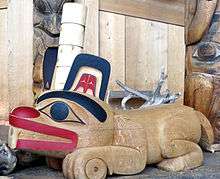Jim Hart (artist)

Jim Hart OBC (born in the early 1950s)[1] is a Canadian and Haida artist and a chief of the Haida Nation.[2][3]
Biography
Hart was born in Massett, Haida Gwaii, British Columbia. His mother, Joan Hart, is the grand-daughter of Charles Edenshaw. His father was European, allowing Hart to escape the Canadian Indian residential school system that many Haida of his time were sent to. Instead, he grew up with his grandparents and became a fisherman.[2]
Hart discovered his passion for Haida art in high school. He began carving seriously in 1979. Hart first apprenticed with Robert Davidson in 1978 to help construct a set of totem poles. From 1980 to 1984 he became an assistant to Bill Reid in Vancouver, who by then was too seriously afflicted with Parkinson's disease to do much of his own carving. He began his work with Reid by putting the finishing details on The Raven and the First Man, a centerpiece of the Museum of Anthropology at UBC, and he also assisted on Reid's Spirit of Haida Gwaii / The Jade Canoe.[2][4]
Hart lives in both Vancouver and Haida Gwaii.[2] In Haida Gwaii, he is known as ˀIdansuu, a hereditary chief name that he received in 1999 after it had earlier been held by Charles Edenshaw.[2][3] As chief he belongs to the Hereditary Chiefs Council of the Haida Nation.[5] He was awarded the Order of British Columbia in 2003.[6]
Works

Hart was the first Northwest Coast artist to use bronze, beginning in 1982, and he has also made works in silver and gold.[2] In 1988, he supervised the construction of the Haida house in the Canadian Museum of Civilization.[7]
A 1995 wood sculpture that Hart considers to be his equivalent of a doctoral thesis, Frog Constellation, depicts two people on the back of a giant frog; it was installed in 2012 on the campus of Simon Fraser University.[8] The Dance Screen, a large wood carving that he began designing in 2009, was installed in 2012 as a temporary exhibit in the Vancouver Art Gallery.[9][10] Another of Hart's works, a totem pole called the Respect to Bill Reid Pole, is part of the outdoor Haida village at the Museum of Anthropology at UBC.[3][11] A bronze sculpture by Hart, The Three Watchmen, is part of the collection of the National Gallery of Canada, and is installed outside the gallery in Ottawa.[12]
References
- ↑ Thom gives a birthdate of 1954, while the Virtual Museum gives 1952.
- 1 2 3 4 5 6 Thom, Ian M. (2009), "Jim Hart", Challenging Traditions: Contemporary First Nations Art of the Northwest Coast, Douglas & McIntyre, pp. 45–49.
- 1 2 3 Jim Hart: artist profile, Virtual Museum of Canada, retrieved 2014-08-15.
- ↑ O'Hara, Jane (April 28, 2003), Reid controversy, The Canadian Encyclopedia, retrieved 2014-08-16.
- ↑ Hereditary Chiefs Council, Council of the Haida Nation, retrieved 2014-08-16.
- ↑ 2003 Recipient: James Hart – Vancouver, Order of British Columbia, retrieved 2014-08-16.
- ↑ Artists – rebirth: Jim Hart, Canadian Museum of Civilization, retrieved 2014-08-15.
- ↑ Jim Hart Sculpture Celebrated at SFU, The Bill Reid Centre for Northwest Coast Art Studies, Simon Fraser University, May 25, 2012.
- ↑ Past Exhibitions: James Hart: The Dance Screen (The Scream Too), Vancouver Art Gallery, 2012, retrieved 2014-08-15.
- ↑ Haida artist Jim Hart raises cedar masterwork in Vancouver: Massive carving The Dance Screen goes on display at Vancouver Art Gallery, Canadian Broadcasting Corporation, January 11, 2013.
- ↑ Lederman, Marsha (November 14, 2007), Opening date set for Bill Reid gallery, The Globe and Mail.
- ↑ Chief James Hart's bronze sculpture The Three Watchmen installed outside the NGC, National Gallery of Canada, November 10, 2011.
External links
- James Hart, Haida Carver, a one-hour documentary by PBS, originally aired June 18, 2009
- Douglas Reynolds Gallery (Vancouver, Canada)